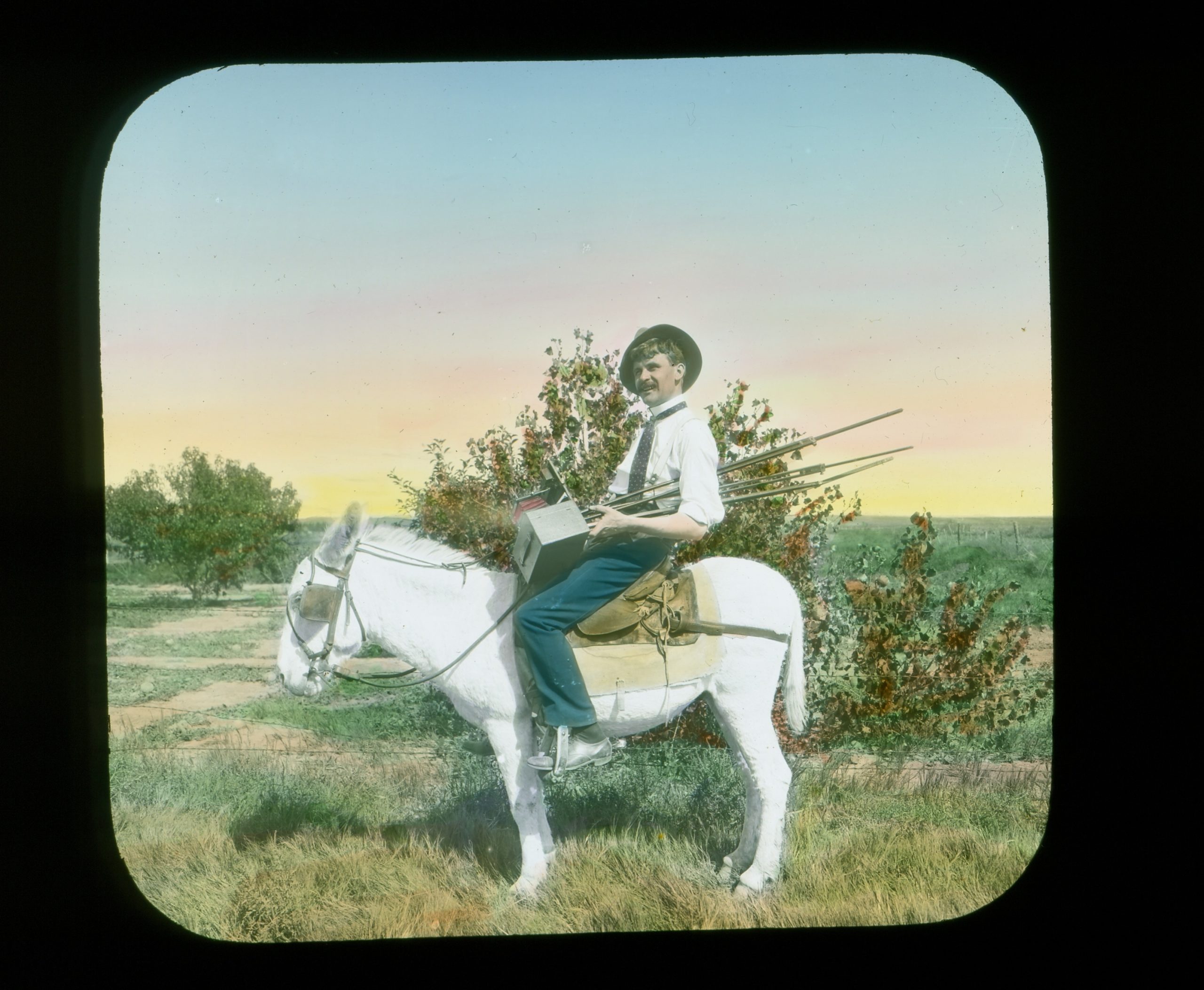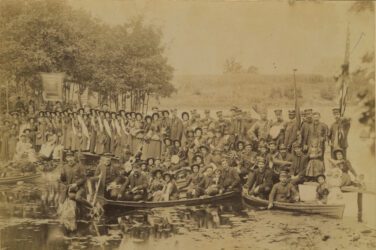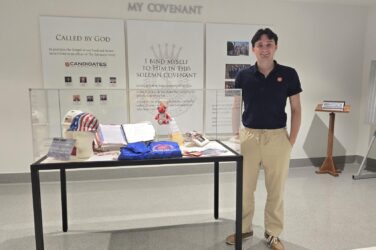When you were a kid, did anyone ever tell you that unless you do X you will never amount to anything? As a boy, Edward Justus Parker certainly heard this sentiment voiced by his Aunt Carrie Cole. She worried that Edward’s propensity to job hop as a pre-teen and teen was a bad sign for his future. Instead, this ability to move from task to task was the key to his success. His insatiable curiosity led him to be innovative and pioneer new ministry methods within The Salvation Army USA.
It was his sense of home and his Aunt Carrie’s nurturing that informed his sense of self, however. Throughout his lifetime Edward viewed himself as a local boy from Elgin, IL. During his Salvation Army career he lived in and traveled to major cities across the United States and Europe. But, no matter where he was, his Elgin roots played heavily in his identity and service to God.
Edward was born in Elgin, IL on August 2, 1869 to George and Myra Parker. Big brother Charles and younger sister Carrie Isabelle rounded out the family. A second sister, Wilhelmina, lived for only fourteen days. George appears in historic records as both a carpenter and machinist. The 1870 census shows the Parkers living with Myra’s parents and sister in Elgin. By 1874 the family moved to Rockford, IL. Sometime between 1874 and 1878 it appears that George and Myra separated. What happened is unclear, but there is evidence that George left his family and eventually moved to the pacific northwest where he died in either 1905 or 1913.
Now a single mother, Myra supported her family through a career promoting temperance in the press and on the lecture circuit. In his autobiography, Edward recalled: “When I was but six or seven years of age I joined one of her organized groups of boys known as ‘The Cold-Water Army.’ With little wooden guns over our shoulders we drilled in the Methodist Sunday-School room and upon being brought to ‘attention,’ we raised our right hands, thereby pledging that cold water would forever be our beverage.”[i]
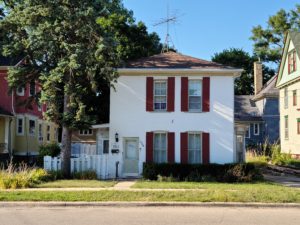
In May 1878 Myra became ill with peritonitis and passed away six weeks later at age twenty-nine. Edward remembered this event vividly. “… I can see her now as she lay in the front room of that little red-brick cottage on Division Street and held her hand in mine, saying, ‘Edward, promise me that you will be a good boy and meet me in Heaven.” Her dying request remained with Edward for the rest of his life and led him to accept Christ and become a Salvationist.
After Myra’s death, her sister, Carrie Cole, took charge of the three children. They appear to have moved from time to time. The 1880 census showed them living with Carrie’s father, Osmond, and her brother Charles and his family, while city directories show them residing at other addresses in Elgin during the decade. Aunt Carrie did her best to keep the children out of trouble, she made sure that they regularly attended church and Sunday School. Despite her efforts, Edward frequently got in trouble with his teachers and was often kept after school.
Edward kept himself busy as a child. From the age of eleven forward he held a series of odd jobs on top of school, moving on to a new job when the old had lost its charm. He spent the money on things that boys in his era coveted: like a pocket watch, a toy box camera, a miniature engine, candy marbles, gingham shirts, and fancy suspenders. He also spent his earnings on violin lessons – though one lesson was quite enough for his taste – and drawing lessons for fifty cents per lesson. Edward shoveled snow off of driveways and sidewalks, stacked firewood, hoed gardens, spent a summer harvesting cucumbers and potatoes on a farm in Crystal Lake, husked corn for the Elgin Packing Company, sold watercress door to door, held a paper route which he sold to another boy due to the inhospitable nature of the local dogs, and pumped the pipe organ at church two to three times per week even though the organist often “forgot” her purse and was unable to pay him.
His most profitable job, which earned him over $3.00 per day, was selling snacks, books, and newspapers on the rail line to Wisconsin. He gave it up at Aunt Carrie’s urging for an apprenticeship in the printing department of the Elgin Daily News. Aunt Carrie, who felt that he was too skinny and frail, worried about his future and repeatedly told him that he would never amount to anything unless he learned a trade.
After his hitch in the Cold-Water Army, Edward expected something quite different when The Salvation Army “bombarded” Elgin on Sunday, June 14, 1885. Instead of the anticipated marching soldiers, guns and drills, the army he found in Fountain Square consisted of five men and a woman. The Salvationists sang while one of them men played a tambourine. The concert was followed by a “free and easy” meeting at Mendleson Hall. It was announced that two female officers, Captain Bluemle and Lieutenant May, would arrive in Elgin as leaders of the new corps.
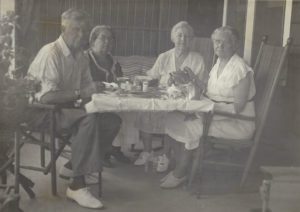
The Army earned its first converts, “two train boys,”[ii] the following week and held its first reported meeting on June 20 across the street from the Jennings Hotel.[iii] They rented space at the Academy of Music for three months. Charles and Edward attended the meetings regularly with both ultimately being saved and becoming soldiers in The Salvation Army. In an 1890 War Cry article, Edward marked the date of his salvation as his sixteenth birthday, August 2, 1885. Their sister, Carrie Isabelle, also became a Salvationist and officer with her husband Daniel Black.
Edward was well versed in selling newspapers and turned his talents to selling The War Cry to earn money for the corps. He also became the corps janitor. By the Fourth of July, the corps had grown. “The Salvation Army is multiplying. There were five women, two children, one babe in arms and a man parading about this week shouting and playing a tambourine.”[iv] In August these parades would ultimately earn Edward and fourteen other Salvationists a night in the local jail for disturbing the peace.[v]
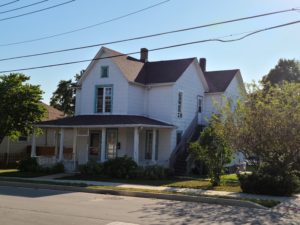
When Edward was called to officership, Aunt Carrie was concerned and again urged him to finish his printing apprenticeship. But, sixteen-year-old Edward persevered and was accepted as a Salvation Army Cadet. He began his first appointment in Janesville, WI on October 1, 1885. Since there was not yet a formal officer training program, he trained on-the-job as the corps officers’ apprentice.
A series of corps officer appointments followed, each after the then standard four-month term. Edward’s work took him to exotic places by his standards. He held appointments in Sterling, Springfield, and Joliet, IL; Minneapolis, MN; and Mobile, AL. He had always wanted to travel, and this was a golden opportunity. Both honored and terrified to be given the assignment of opening the South for The Salvation Army, his four months in Mobile were such a world away from what he had known that, at first, Edward thought it would be missionary work. But, soon enough, he was back in Minneapolis where he was tasked with opening yet another corps. He rose through a series of promotions just as rapidly, moving through the ranks of Cadet, Lieutenant, Captain and Ensign during his first five years as an officer.
Edward’s appointments often required that he learn new skills in a hurry. At age twenty he was appointed Bandmaster for the Illinois Division Band, which was a prestigious appointment to be sure. Except Edward didn’t know how to read music. Over the previous four years he taught himself to play the concertina and cornet. Now he locked himself in his quarters to figure out sheet music, a secret that he never revealed to the band. He also taught himself to play the slide trombone since the band needed one more musician.
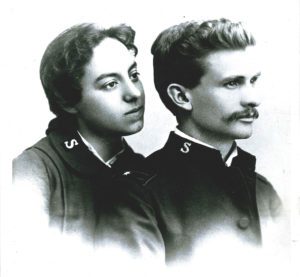
While serving as District Officer (Commander) of the Massachusetts District Edward met and married fellow Salvationist Eva Thompson. After the birth of their second child, Aunt Carrie left Elgin and moved in with the young family. They would ultimately have six children.
As national Trade Secretary, Edward – now known as Brigadier Parker – revolutionized the production, supply and products of the department. In this appointment he was finally able to indulge in his love of photography and was instrumental in implementing the widespread use of slides and moving pictures in the American Salvation Army ministry. Like his mother, Edward was an excellent public speaker. He developed lectures and toured the country using his photographic talents to illustrate his presentations and engage the viewer. The programs also raised essential funds for the Army. He designed both photographic and movie cameras and published a book about the photographic process.
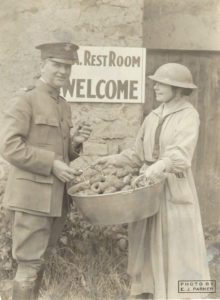
Edward’s photography would serve him well in his appointment as Social Services Secretary, which he held for twenty-eight years. Here, his photographs and film brought attention to inner city poverty and documented the Army’s service to the troops during World War I for a national audience.
Ultimately the variety skills he acquired through his appointments helped him to be selected as National Secretary (later renamed National Commander) where he took the reigns as leader of The Salvation Army in the United States. In 1940, as America once again geared up for war, Edward helped bring interested service organizations together establishing the United Services Organization (USO), of which he was considered a founding member.
The Elgin boy who held so many odd jobs was called into a ministry that perfectly suited his ability to rapidly change tasks and master new skills. Edward Parker’s love for God and promise to his late mother defined his life and gave him purpose. He often wished that Aunt Carrie, who passed away in 1913, could see the culmination of his fifty-eight-year long career.
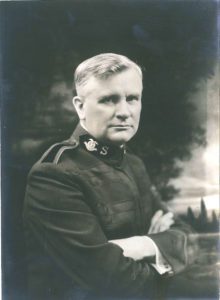
Commissioner Edward Parker, National Commander of The Salvation Army USA, retired in 1943 after fifty-eight years of service. His legacy included the establishment of the USO, using photography and film to bring the work of The Salvation Army into American homes, and embracing emerging technologies to support ministry. He was Promoted to Glory in 1961 at age 91. Towards the end of his Salvation Army career he returned to Elgin to tour his old neighborhood and reminisce about how far life and his faith in God had taken him.
Career Summary
Oct. 1885 Janesville, WI – Cadet
Nov. 1885 Sterling, IL
March 1886 Joliet, IL
May 1886 Chicago (Temple / Princess Rink / 3), IL
Oct. 1886 Minneapolis (Citadel / 1), MN – Lieutenant
Dec. 1886 Minneapolis (Temple / 2), MN – Captain
March 1887 Mobile, AL
May 1887 Minneapolis (Central / 3), MN
Sept. 1887 Monroe, WI
March 1888 Springfield, IL
Oct. 1888 Chicago (2), IL
May 1889 Red Wing, MN
Sept. 1889 Bandmaster, Illinois Divisional Band
Nov. 1889 Decatur, IL
Dec. 1889 Des Moines, IA Training Garrison
Sept. 1890 Omaha, NE Training Garrison – Ensign
March 1891 District Officer, Connecticut
Oct. 1891 Assistant District Commander, New England Division
Jan. 1892 District Officer, Eastern Massachusetts – Adjutant
Jan. 1895 General Secretary, New England Province – Staff-Captain
June 1896 Major
Aug. 1896 General Secretary, Northwestern Province
May 1898 General Secretary, Central Province
Dec. 1898 Assistant Trade Secretary
Jan. 1901 Trade Secretary – Brigadier
Oct. 1903 National Metropole and Relief Secretary
Jan. 1905 Private Secretary to the Chief Secretary for National Social Work
Nov. 1907 Social Secretary, Eastern Territory – Lt. Colonel
June 1915 Colonel
July 1918 War Service Secretary (Addl. designation)
March 1927 Chief Secretary, Eastern Territory
Jan. 1930 National Secretary (National Commander) – Lt. Commissioner
March 1934 Commissioner
Dec. 1943 Retired
[ii] Elgin Daily Courier, June 18, 1885, p. 4.[i] Edward Justus Parker, in My Fifty-Eight Years: an Autobiography: an Intimate Résumé of Fifty-Eight Years’ Service as a Salvation Army Officer in the United States (New York, NY: National Headquarters, 1943), p. 171.
[iii] Elgin Daily Courier, June 20, 1885, p. 4.
[iv] Elgin Every Saturday, July 4, 1885, p. 8.
[v] Chicago Tribune, August 25, 1885, p. 10.
Featured image: Tinted glass slide, Edward Parker with camera on donkey. Possibly taken during a photographic trip to Yellowstone National Park. Image courtesy The Salvation Army National Archives and Research Center

